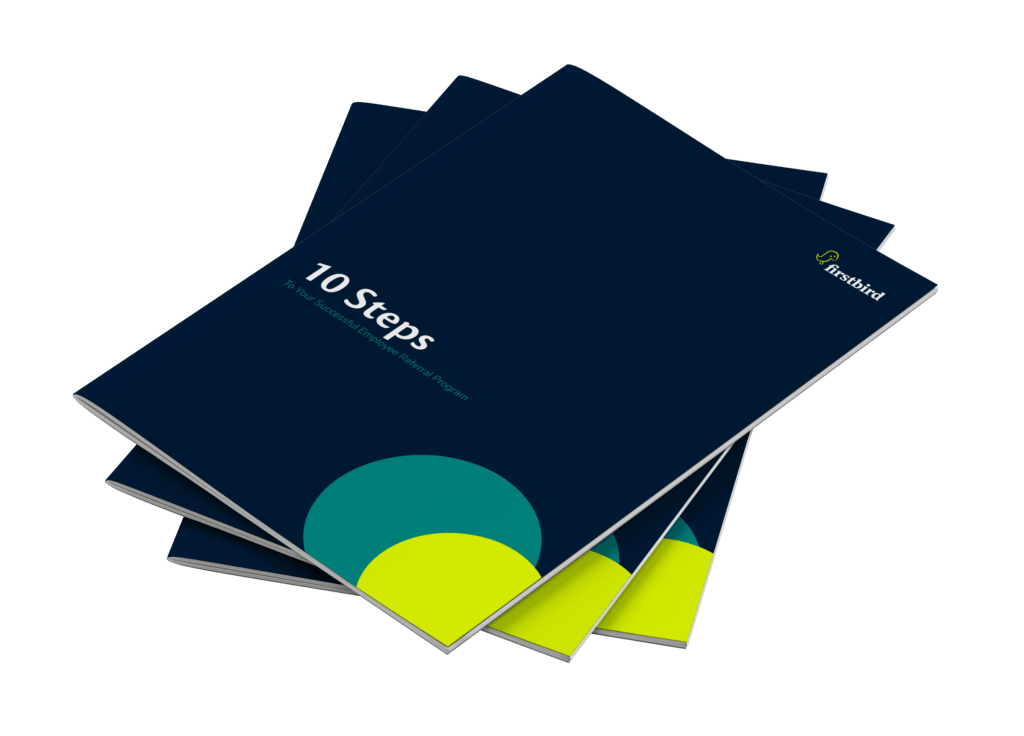What Is an Applicant Tracking System?
An Applicant Tracking System (ATS) is software that supports the HR managers in handling the application process. It makes their work more accessible because they can collect and process all information in one place. The digital Applicant Tracking System works according to the pre-determined criteria and is based on AI.
It helps the recruiter with active sourcing, writing and publishing job offers, pre-selection, and the subsequent hiring process. It also motivates candidates to rate the application process positively. Therefore, they feel well looked after and well informed at every touchpoint of their candidate journey. The best applicant tracking systems even have HR functions. For example, if you use Firstbird for your employee referrals, you can combine it with various proven ATS.
What Are the Advantages of an Applicant Tracking System?
The Applicant Tracking System has the following advantages:
- The more efficient and transparent recruiting process
- Lower HR costs and error rates
- Faster processing of application documents
- Quick and effective comparison between applicants
- Precise tracking of the data
- Immediate availability of the prepared documents and data
- No loss of application documents
- Encrypted, audit-proof and legally secure storage of the data
- Faster filling of vacancies
- Avoid double editing the same information for all HR employees
- The professional appearance of the company in public
- Gaining an advantage over competitors who still conventionally track the applicants.

How Does an Applicant Tracking System Work?
Applicant tracking systems avail of various templates and several automated processes. The software accompanies all stages of the hiring process up to onboarding, including the phases of the application interviews up to the selection of the suitable candidate. Many efficient applicant tracking systems also have a points system (scoring) that helps compare the characteristics and qualifications of the candidates with the positioning requirements.
An ATS supports the recruiter with active sourcing through the integrated sourcing tool since the manual search for suitable candidates is time-consuming and labour-intensive. The pre-selection function consists of a chatbot that presents the applicants according to the questions previously set, provides an overview of the answers, and suggests suitable candidates.
After the pre-selection, the internal vote takes place. To ensure that applicants receive a quick response, the recruiter shares the evaluation data with everyone involved in the hiring process. If the HR manager is not able to select a candidate because of the flood of suitable applications, they invite the qualified candidates to do special tests. The integrated test tools check skills that are important for the advertised position, such as abstract thinking, for example. Those who pass the test are invited to an interview. The other applicants will receive a rejection by email.
In both cases, the Applicant Tracking System provides the appropriate templates that only need to be adapted. Of course, the recruiter also can add rejected applicants to his talent pool and contact them for future vacancies.
What Features an Applicant Tracking System Must Have?
A suitable Applicant Tracking System is optimally adapted to operational needs. For instance, small businesses that rarely hire employees can generally get by with the basic functionalities. It consists of writing job advertisements and simultaneously publishing them on specific job boards (multiposting), creating a career page, and building a talent pool. But, of course, smaller companies can also benefit from an ATS with more extensive functionalities.
Medium-sized and large companies with more extensive HR work should use HR software to cover the entire recruiting workflow. Usually, such an Applicant Tracking System is associated with higher purchasing costs. Nevertheless, it is a worthwhile investment if the company looking for new hires belongs to an industry affected by the shortage of skilled workers.
Because good recruiting software has additional analysis and evaluation tools, the HR manager can always find key data. For example, they can see where the applicants are located and within which channel they perform best. In addition, integrated application forms help to compare candidates faster and more precisely.
To do this, the HR manager enters specific criteria that are important for the advertised position and the company looking for a new employee. The answers given by the applicants are recorded and evaluated by the system. Ranking and matching functions are available for pre-selection.
Moreover, cloud-based applicant tracking systems have proven to be particularly practical. The recruiter does not have to download the software initially but can still quickly and independently use it during the hiring process. The SaaS solutions that allow operating via a browser are also advantageous financially for SMEs and young start-ups with little capital.
Therefore, selecting the most suitable candidate is a child’s play with an ATS. The recruiter shares the candidate profiles in question with the HR colleagues and receives their feedback via the comment function. By defining the access rights to applicants’ profiles, the HR manager can determine who in the company can access information regarding the candidates.
Communication with applicants takes place through automated emails. They can be easily created with ready-made templates. In this way, the HR manager can keep the applicants up to date on their application process and stays in contact with promising candidates.
In addition, with a good ATS, they can personalize their own workflow and set reminders for its different stages for completing the tasks on time. A good applicant tracking software also ensures that job applications can be submitted directly through the application form.
Furthermore, its link should be added to job ads posted contemporarily on several online job boards (multiposting). ATS also allows publishing the job offers both online and in a print version. In addition, the HR manager can share the job ads on social media and other channels (e.g., the company’s career page).

What Are the Requirements for an Applicant Tracking System?
Practical software solutions for candidate sourcing must be easy to use for the recruiters and, if necessary, employees from other departments without a particular training period. It should contain a functional layout for templates and text modules for writing job advertisements. The best applicant tracking systems also include functions to automatically evaluate candidates and check the hiring criteria.
Of course, applicant tracking must also meet data protection requirements: only employees who are directly involved in recruiting personnel may have access to the personal data. Rejected applicants who have not consented to their data being saved must be deleted from the system immediately.
HR employees are allowed to collect, process, and use the personal data required for applicant tracking according to the company’s privacy policy. However, the introduction of the recruiting software does not have to be approved by the management board. Nevertheless, it is advisable to inform them about it.
If you would like to combine your applicant tracking system with an employee referral program, we recommend the 10-step guide for introducing an employee referral program.
Download the employee referral guide
Did you know that the impact of referrals is so big it can help you fill more than 50% of your vacant positions?

























